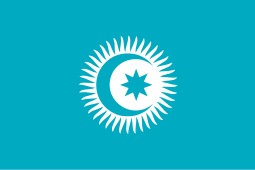
The flag of Europe or European flag consists of twelve golden stars forming a circle on a blue field. It is the official flag of the European Union. It was designed and adopted in 1955 by the Council of Europe (CoE) as a symbol for the whole of Europe.

The national flag of the Democratic People's Republic of Korea, commonly known as North Korea, consists of a wide horizontal red stripe bordered above and below by a thin white stripe and a broad blue stripe. The red stripe is charged near the hoist with a five-pointed red star inside a white disc. The design of the flag is defined in the North Korean constitution and regulations regarding the use and manufacture of the flag are outlined in the country's national flag law. The North Korean government credits Kim Il Sung, the country's founder and first leader, as the designer of the flag. The flag was officially adopted on 8 September 1948, with the passing of North Korea's first constitution by the Supreme People's Assembly. The North Korean flag is banned in South Korea by the National Security Act.

The flag of North Macedonia depicts a stylized yellow sun on a red field, with eight broadening rays extending from the center to the edge of the field. It was created by Miroslav Grčev and was adopted on 5 October 1995.

The Turkish Radio and Television Corporation is the national public broadcaster of Turkey, founded in 1964. TRT was for many years the only television and radio broadcaster in Turkey. Before the introduction of commercial radio in 1990, and subsequently commercial television in 1992, it held a monopoly on broadcasting. More recent deregulation of the Turkish television broadcasting market produced analogue cable television. Today, TRT broadcasts around the world, including in Europe, the Middle East, Africa, Asia, the United States, and Australia.

Under the Geneva Conventions, the emblems of the International Red Cross and Red Crescent Movement are to be worn by all medical and humanitarian personnel and also displayed on their vehicles and buildings while they are in an active warzone, and all military forces operating in an active warzone must not attack entities displaying these emblems. The International Red Cross and Red Crescent Movement recognizes four protection emblems, three of which are in use: the Red Cross, the Red Crescent, the Red Lion and Sun, and the Red Crystal.

Turkey has no official national emblem, but the crescent and star design from the national flag is in use on Turkish passports, Turkish identity cards and at the diplomatic missions of Turkey.

The Presidential Seal of Turkey is a symbol used to represent the president of Turkey. It has a large 16-pointed Sun in the center which symbolizes the Republic of Turkey. The sun is surrounded by 16 five-pointed stars, symbolizing the 16 Great Turkic Empires in history.

The Organization of Turkic States (OTS), formerly called the Turkic Council or the Cooperation Council of Turkic Speaking States, is an intergovernmental organization comprising all but one of the internationally recognized Turkic sovereign states: Azerbaijan, Kazakhstan, Kyrgyzstan, Turkey, and Uzbekistan; while Hungary, Turkmenistan and Northern Cyprus are observers. Its overarching aim is promoting comprehensive cooperation among the Turkic peoples. First proposed by Kazakh president Nursultan Nazarbayev in 2006, it was founded on 3 October 2009 in Azerbaijan's Nakhchivan. The General Secretariat is located in Turkey's Istanbul.

The International Organization of Turkic Culture or TÜRKSOY is an international cultural organization of countries with Turkic populations, speaking languages belonging to the Turkic language family.
Culture and Arts Capital of the Turkic World, is a city designated by the TÜRKSOY for a period of one calendar year during which it organises a series of cultural events.
The Turkic Academy, previously known as Turkic World Educational and Scientific Cooperation Organization, or International Turkic Academy is an international institute for Turkology research involving Azerbaijan, Kazakhstan, Kyrgyzstan and Turkey. Hungary and Uzbekistan have observer status.

Relations between Turkic Council and Azerbaijan started from the year of 2009 until present. Taking into account of the establishment date of the organization, Azerbaijan continues relations as a member of the founding country.

The TURKPA in full, the Parliamentary Assembly of Turkic States, is an international organization comprising some of the Turkic countries. It was founded on 21 November 2008 in Istanbul. The General Secretariat is in Baku, Azerbaijan. The member countries are Azerbaijan, Kazakhstan, Kyrgyzstan and Turkey. Hungary and Northern Cyprus are observers.
The flag of Earth is a concept of a possible flag design meant to symbolize the planet Earth, humankind, or a possible world government.

The Supreme Order of Turkic World is the highest order of the Organization of Turkic States. The order is awarded by the chairperson of the organization, who is simultaneously the head of state or head of government of one of the member countries. Established in 2019, the order recognizes outstanding service to the Turkic World.
National symbols of Turkey are symbols used to represent the citizens of the Republic of Turkey in Turkey and around the world.
The Turkic Council of Elders. is an advisory body within the Organization of Turkic States (OTS). Hero-Arkadag emphasized the significant role of the Council of Elders in fostering unity among the Turkic people through the preservation, traditions, and customs.

The 2024 Organization of Turkic States summit, officially the 11th Meeting of the Council of Heads of State of the Organization of Turkic States summit, was a meeting between the leaders of the Organization of Turkic States in Bishkek, Kyrgyzstan, on 6 November 2024.















